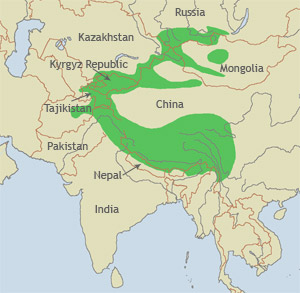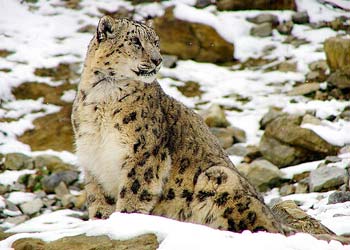The snow leopard's range in central and south Asia is rugged mountainous regions of approximately 1,230,000 square kilometres (470,000 sq mi), which extends through twelve countries: Afghanistan , Bhutan , China , India , Kazakhstan , the Kyrgyz Republic , Mongolia , Nepal , Pakistan , Russia , Tajikistan , and Uzbekistan .
The geographic distribution runs from the Hindukush in eastern Afghanistan and the Syr Darya through the mountains of Pamir Mountains , Tian Shan , Karakoram , Kashmir , Kunlun , and the Himalaya to southern Siberia , where the range covers the Russian Altai mountains , Sajan , Tannu-Ola mountains and the mountains to the west of Lake Baikal . In Mongolia it is found in the Mongolian and Gobi Altai and the Khangai Mountains . In Tibet it is found up to the Altyn-Tagh in the North.
Snow leopard range covers 2 million square kilometers, about the size of Greenland or Mexico. China contains as much as 60% of snow leopard habitat . The cats have already disappeared from some areas where they formerly lived, such as certain parts of Mongolia.
Much of the snow leopard 's habitat is located along international borders, some of them disputed between two countries. To some degree, this situation protects the cats because sensitive border areas are often closed to all public access, making them almost de-facto protected areas. But it also adds to the difficulty of studying snow leopard s and establishing their current status and distribution.
Snow leopard s are usually found between 3,000 and 5,400 meters above sea level. The environment at this elevation is harsh and forbidding. The climate is cold and dry, the mountain slopes sparsely vegetated with grasses and small shrubs.
Snow leopard s prefer steep, broken terrain of cliffs, rocky outcrops, and ravines. This type of habitat provides good cover and clear views to help them sneak up on their prey.
Each individual snow leopard inhabits a defined home range. However, these home ranges overlap and snow leopard s do not defend them the way more aggressively territorial species do. Home range sizes vary greatly. It is thought that in Nepal and other areas where prey is abundant, cats inhabit home ranges as small as 30-65 square kilometers. In areas where there is less prey, such as Mongolia, snow leopard s need more land in order to survive and their home ranges may be over 1,000 square kilometers in area.
As they move about their home ranges, the cats often travel along ridgelines and cliff bases, and choose bedding sites near cliffs or ridges with good views over the surrounding terrain.
Radio collar studies of snow leopard s in the wild indicate that they usually stay in one area for several days and then move to another part of their home range--usually to another valley, where they might find another herd of potential prey. They can cover long distances in a single night, and in Mongolia they have even been documented to cross over 25 miles of open desert between mountain slopes.




